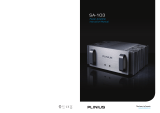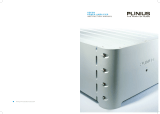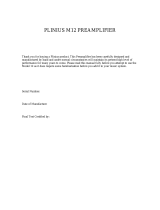Plinius SA-REFERENCE User manual
- Category
- Home audio sets
- Type
- User manual
This manual is also suitable for

Class A Power Amplifier

2

3
CONGRATULATIONS
CONGRATULATIONSCONGRATULATIONS
CONGRATULATIONS on your decision to become the proud owner of this
Plinius SA-250 Power Amplifier.
This manual has been prepared to help you understand the operation of your amplifier, and to provide
information about its design and the variety of ways it may be used.
We have designed and manufactured this amplifier to reproduce faithfully and accurately, your favourite
music. With a little care and a full understanding of the operating recommendations in this manual, your
Plinius SA-250 Power Amplifier will provide years of high-quality, trouble-free performance.
Serial Number: ..................................................................................
Date of Manufacture: ..................................................................................
Final Test Certified By: ..................................................................................
IMPORTANT: PLEASE TAKE THE TIME TO READ THIS MANUAL
THOROUGHLY BEFORE USING YOUR AMPLIFIER.

4
Introduction ........................................................................................................................................Page 3
Precautions ........................................................................................................................................Page 5
Amplifier Features - FRONT PANEL .....................................................................................................Page 6
Amplifier Features - REAR PANEL .......................................................................................................Page 8
Amplifier Configuration Selector (ACS) ...............................................................................................Page 9
Balanced/Unbalanced Signals ..........................................................................................................Page 10
Installation and Operation .................................................................................................................Page 12
Input/Output Connection ...................................................................................................................Page 13
RCA Connection ...............................................................................................................................Page 14
XLR Connection ................................................................................................................................Page 15
SA-250 Features ..............................................................................................................................Page 17
Loudspeaker Selection .....................................................................................................................Page 19
Why Class A is better .......................................................................................................................Page 20
Specifications ..................................................................................................................................Page 21
Index ................................................................................................................................................Page 22
Contact Details .................................................................................................................................Page 23

5
Please take special note of the following precautions before operating your new amplifier:
• The Plinius SA-250 Power Amplifier can be operated in bridged mode and may deliver in excess of
900 watts into 8 ohms. This amplifier is also capable of a very large peak current delivery.
• The Plinius SA-250 Power Amplifier operates in Class A. It is capable of generating temperatures that
could have an adverse effect on other equipment, furniture etc. DO NOT leave flammable material on
the amplifier whilst running, as this could pose a serious fire risk.
• The Plinius SA-250 Power Amplifier is of direct-coupled design, and offers no protection from
preamplifiers that have a high DC component at their outputs.
• This amplifier operates at hazardous voltage levels. We recommend that any work requiring removal
of the lid or base of this amplifier be referred to a suitably qualified and experienced service
technician.
• DO NOT attempt to connect any input of this amplifier to it’s own outputs.
• DO NOT earth any output terminal or connect any of these terminals together without following the
instructions in this manual or seeking qualified assistance.
• DO NOT place this amplifier in any position where liquids or any foreign material may accidentally
enter it.
• DO NOT connect any voltage source, short circuit, earth/ground or appliance (other than suitable high
fidelity loudspeakers) to the amplifier output terminals.
• Some preamplifiers, processors, CD players’ etc. produce large switching pulses when switched on
causing a loud click through the loudspeakers. For this reason, turn on all other equipment in your
system before turning on your Plinius SA-250, or ensure that the amplifier is in MUTE. You will not
experience this phenomenon with Plinius Preamplifiers.

6
The front of the Plinius SA-250 Power Amplifier incorporates a small panel fitted with three switches.
These switches control the functions most used on the amplifier.
FRONT PANEL LAYOUT SHOWING MUTE, MAINS AND BIAS SWITCHES
The operation of these switches is, from the left:
MUTE SWITCH
It is not recommended practice to interfere with the input cables while the amplifier is switched on and
connected to the loudspeakers, so a Mute switch is fitted to interrupt the input signal. This allows you to
connect and disconnect the input cables without the necessity of turning the amplifier off.
The switch operates on a pulse system in conjunction with an LED indicator. When the amplifier powers
up from start, the Mute automatically engages and has to be switched for normal listening. The Mute
switch also disconnects the speakers while the LED is on. Take care not to touch any terminals other than
the outputs when changing the output (loudspeaker) leads.
MAINS SWITCH
This heavy-duty rocker switch in the centre of the panel turns the Mains/Line Power to the amplifier ON or
OFF. An LED in the centre of the front panel indicates that the power is on. When first switched on the
power LED will pulse for ten seconds - this is an initialisation sequence, after which the power LED
remains lit. The amplifier draws a moderately high current when switched on. Despite the "Soft Start
Circuit" within the amplifier reducing current demand on the mains as the amplifier is switched on, it is
not good practice to rapidly turn the Mains switch on and off repeatedly.
MUTE
A BIAS

7
BIAS SWITCH
This switch on the right of the panel alters the operating bias of the amplifier. The switch operates on a
pulse system and lights the Bias LED when the amplifier is switched to Class A. In Class AB the LED is
off.
BIAS AB:
BIAS AB:BIAS AB:
BIAS AB: This position reduces the bias on the output stage to operate the amplifier in Class AB. This is
a bias configuration used by the majority of high fidelity amplifier designers for their products. In Class
AB your Plinius SA-250 produces very high quality sound, suitable for all occasions where ‘super critical’
listening is not a priority. The quality of performance in this mode may exceed that of many other
amplifiers so a dual benefit exists in that this facility provides the user with a much cooler operating
temperature, and a much reduced demand on electricity particularly at idle (while the amplifier is not
reproducing music). This unique feature allows you to leave the Plinius SA-250 switched ON at all times,
rendering the amplifier ready for use and requiring only a few minutes of warm-up in Class A before the
very best of the amplifier's sonic qualities may be experienced.
BIAS A
BIAS ABIAS A
BIAS A:
::
: This position provides a true Class A bias to the output stage therefore ensuring the optimum
performance of the amplifier during all listening events. Class A amplifiers run hotter than Class AB
amplifiers, hence our specially designed and distinctive heat sinks. Operating the amplifier in BIAS A
necessitates two precautions that should be observed.
1.
1.1.
1. On switching to BIAS A, the temperature of the amplifier will quickly increase and the amplifier will
become quite hot. Once again we remind you to ensure that you have left adequate space around
the amplifier for ventilation. Ensure that no objects are resting on the amplifier and check that the
heat sink (cooling fins) are not obstructed in any way.
2.
2.2.
2. The current required from the mains supply in BIAS A is approximately 1,000 watts, similar to a
small electric heater. The amplifier should not be connected to a wall outlet that is shared with
other heavy current appliances such as heaters or electric motors. If in doubt, check with your
Plinius dealer for advice.

8
This panel incorporates all the terminals for connecting the input signals from your preamplifier, and
output to the loudspeakers, and mains supply. A reasonable understanding of this amplifier and a logical
approach should ensure that you are listening to this amplifier without any difficulties at all.
Please remember that your Plinius SA-250 Power Amplifier is a high quality electronic instrument capable
of an exceptional level of performance. Be sure that you understand your system’s requirements fully
before you make any connection to this amplifier or adjust the ACS (Amplifier Configuration Selector).
REAR PANEL OF THE PLINIUS SA-250 SHOWING ALL OF THE AVAILABLE
FACILITIES INCLUDING INPUT AND OUTPUT TERMINALS, ACS (AMPLIFIER
CONFIGURATION SELECTOR), MAINS INPUT AND GROUND LIFT.
A
MPLIFIER CONFIGURATION SELECTOR
REFER TO OWNERS MANUAL FOR USAGE INSTRUCTIONS
RCA STEREO
RCA BRIDGED MONO
XLR BALANCED MONO
XLR STEREO
RIGHT INPUTS
LEFT INPUTS
DESIGNED AND MANUFACTURED IN
NEW ZEALAND BY
AUDIBLE TECHNOLOGIES LTD
P.O. B OX 1836
PALMERSTON NORTH
CAUTION
RISK OF ELECTRICAL SHOCK
DO NOT OPEN
CAUTION:
TO REDUCE RISK OF
COVER. NO USER SERVICEABLE
PARTS INSIDE. REFER SERVICING TO
QUALIFIED SERVICE PERSONNEL.
SERIAL No.
POWER
CONSUMPTION
50/
60
2000VA
VOLTAGE Hz.
PLINIUS
SA-250 MkIV
STEREO POWER AMPLIFIER
GROUND
LIFT
CHASSIS
OPEN
RIGHT OUTPUTS
LEFT OUTPUTS
CAUTION: ENSURE ADEQUATE VENTILATION

9
INPUT TERMINALS
Input terminals for your Plinius SA-250 Power Amplifier are easily accessible and fitted to the top centre
area of the rear panel. A brief summary of connection possibilities is listed below, while a more detailed
explanation follows later in this instruction manual.
RCA INPUTS LEFT & RIGHT:
RCA INPUTS LEFT & RIGHT:RCA INPUTS LEFT & RIGHT:
RCA INPUTS LEFT & RIGHT: These standard RCA terminals are for use with unbalanced signals from
most signal sources such as audio preamplifiers.
XLR BALANCED INPUTS LEFT & RIGHT
XLR BALANCED INPUTS LEFT & RIGHTXLR BALANCED INPUTS LEFT & RIGHT
XLR BALANCED INPUTS LEFT & RIGHT:
::
: XLR connectors fitted to this amplifier are for use with balanced
line signals from audio preamplifiers. Balanced signals are carried via a three way cable that connects all
three pins at each end of the interconnect cable.
AMPLIFIER CONFIGURATION SELECTOR (ACS)
The Amplifier Configuration Selector (ACS) is a unique switching method that exploits all of the
operational features of your Plinius SA-250 Power Amplifier. By using this switch it is possible to operate
your amplifier with either balanced or unbalanced signals and achieve a stereo or mono output.
Stereo or Mono use of this amplifier will depend on the type of ancillary equipment employed with your
system. If you wish to use this amplifier as a single channel (mono) Power Amplifier in a stereo high
fidelity system, then another SA-250 will be required for the other channel. This will provide an extremely
high performance option.
AMPLIFIER CONFIGURATION SELECTOR
REFER TO OWNER’S MANUAL FOR TECHNICAL DESCRIPTIONS
* ALL MONO/BRIDGE OPTIONS USE RIGHT INPUT AND
LEFT + RIGHT + OUTPUTS ONLY
RCA STEREO
RCA BRIDGED MONO
XLR BALANCED MONO
XLR STEREO
AMPLIFIER CONFIGURATION SELECTOR
The ACS switch options are:
RCA STEREO
RCA STEREORCA STEREO
RCA STEREO: This option provides a stereo output via both left and right output channels from a stereo
signal connected to both left and right input RCA inputs.

10
RCA BRIDGED MONO:
RCA BRIDGED MONO:RCA BRIDGED MONO:
RCA BRIDGED MONO: This option configures your amplifier to drive one loudspeaker from one
unbalanced signal fed to the RIGHT RCA input. The loudspeaker is connected to both channels positive
(+) output terminals, giving an available power in this mode four times the rated output of the amplifier,
approximately 900 watts into 8 ohms. Special care must be taken in connecting the input signal and
loudspeakers to ensure safe operation and best possible performance.
XLR STEREO:
XLR STEREO:XLR STEREO:
XLR STEREO: This option provides a stereo output signal from a balanced stereo input signal connected
to both the left and right XLR inputs. All the advantages of balanced line transmission will be realised with
good rejection of noise and some freedom from earth or ground loops (hum).
XLR BALANCED MONO:
XLR BALANCED MONO:XLR BALANCED MONO:
XLR BALANCED MONO: In this mode both channels of your Plinius SA-250 combine to operate as a true
balanced mono amplifier, from input to output. This configuration provides the highest quality mono
performance from a balanced line input connected to the RIGHT BALANCED XLR INPUT. As with RCA
Bridged configuration, the loudspeaker is connected to both channels positive (+) output terminals.
Available power in this mode is four times the rated output of the amplifier, approximately 900 watts RMS
into 8 ohms. Special care must be taken in connecting the input signal and loudspeakers to ensure safe
operation and best possible performance.
BALANCED/UNBALANCED SIGNALS
Balanced or unbalanced input options will depend on the type of signal available from your preamplifier or
other equipment. The Plinius SA-250 provides both options to allow you to choose the most suitable
preamplifier for your purposes. Plinius Preamplifiers offer both balanced and unbalanced output options.
BALANCED LINE
BALANCED LINEBALANCED LINE
BALANCED LINE is normally used to transmit signals in a professional environment. Because balanced
line effectively reduces or eliminates noise pick-up by the system cabling, it has become increasingly
more important in high-quality domestic high fidelity systems.
UNBALANCED
UNBALANCED UNBALANCED
UNBALANCED leads such as single ended, RCA or coaxial are common and are used in the majority of
audio signal systems. The terminal plug and socket are most commonly called RCA and can be found on
your Plinius SA-250 for use as the standard input terminals for both left and right inputs.
OUTPUT TERMINALS - STEREO
Output connections for the loudspeakers are provided on the left and right hand side of the rear panel.
Two parallel pairs of binding posts for each channel are fitted – these provide ease of use with bi-wiring
and multiple cables requiring a large contact area.
OUTPUT TERMINALS - BRIDGED/MONO
In bridged/mono modes, the loudspeakers utilise only the positive (+) outputs of your Plinius SA-250. In
this configuration power output to the loudspeakers is dramatically increased (around four times as
much), and is commonly used in conjunction with another amplifier for amplification of each channel
from the preamplifier.

11
Please note that in order to achieve STEREO performance in either of the Mono modes, it will be
necessary to use two Plinius SA-250 Power Amplifiers - one amplifier each for left and right channels.
GROUND LIFT SWITCH
This switch is located adjacent to the Mains Input Socket, and allows the signal ground to be
disconnected from the chassis. In some installations a hum loop may exist due to duplicate ground paths
from different equipment. Use this switch to remove the connection from 0V to ground thus allowing
some flexibility in your particular set-up.
MAINS POWER CORD IEC CONNECTOR
This connector is where the mains supply cable from your wall connects to the amplifier. You will notice
that a fuse holder is mounted within this connection, and it holds a mains fuse to provide surge and
overload protection for your amplifier.

12
PLACEMENT AND VENTILATION
Your Plinius SA-250 is designed to operate at a moderately high temperature, even more so when used in
Class A. The ideal location is on a rigid stand or floor mounted away from direct contact with any
temperature sensitive materials or deep pile carpets. The flow of air around the amplifier should also be
kept unimpeded, so ensure that the heat sinks (cooling fins) are not covered or restricted in any way to
ensure adequate ventilation.
The Plinius SA-250 design incorporates a very high level of mechanical decoupling of the input and
output. It can however still be influenced by acoustical feedback in the operating environment. The use of
acoustic cones or a suitably spiked amplifier stand or table may further enhance the performance of this
amplifier. Consult your PLINIUS
PLINIUSPLINIUS
PLINIUS dealer for further advice if required.
MAINS VOLTAGE CONNECTION
Firstly check that the mains supply voltage printed on the rear of this amplifier is similar to the mains
supply voltage in your area. If in doubt, please consult your PLINIUS
PLINIUSPLINIUS
PLINIUS dealer.
Mains supply power connection is via the supplied plug-in lead. A standard IEC socket connects the
mains power at the amplifier end while a local mains plug is required at the wall end.
The wiring code used inside all Plinius product is:
Gr
GrGr
Green to Earth/Ground
een to Earth/Groundeen to Earth/Ground
een to Earth/Ground
Blue to Neutral
Blue to NeutralBlue to Neutral
Blue to Neutral
Brown to Phase/Live
Brown to Phase/LiveBrown to Phase/Live
Brown to Phase/Live
Should a ‘local’ plug need fitting to the wall end of the lead, ensure that a suitably qualified or experienced
service technician wires the plug correctly.
IMPORTANT: DO NOT POWER UP YOUR AMPLIFIER UNTIL YOU HAVE
CONNECTED YOUR INPUT/OUTPUTS CORRECTLY FOR
YOUR SYSTEM, (AS EXPLAINED IN THE NEXT SECTION).

13
REAR PANEL SHOWING LOCATION OF INPUT/OUTPUT TERMINALS
It is important that you connect your loudspeakers (outputs) and preamplifier (inputs) to the Plinius SA-
250 Power Amplifier correctly to ensure the amplifier is not damaged, and sounds it’s best with your
system. Now that you have read and familiarised yourself with the connections on the back of the
amplifier as covered in the previous section, we will describe in detail the different ways in which you can
connect the amplifier to your system.
There are essentially four different ways that you can connect your system components to the Plinius SA-
250 Power Amplifier:
1. RCA STEREO
2. RCA BRIDGED MONO
3. XLR STEREO
4. XLR BALANCED MONO
AMPLIFIER CONFIGURATION SELECTOR
REFER TO OWNERS MANUAL FOR USAGE INSTRUCTIONS
RCA STEREO
RCA BRIDGED MONO
XLR BALANCED MONO
XLR STEREO
RIGHT INPUTS
LEFT INPUTS
RIGHT OUTPUTS
LEFT OUTPUTS

14
RCA STEREO
Connect your preamplifier or input signal to the two RCA inputs at the top of the amplifier back panel.
Make sure you connect the red coded cable to the red RIGHT RCA input and the black (or white) cable to
the black LEFT RCA input. Also make sure the RCA connectors are a snug fit and are inserted all the way
in.
Next connect your loudspeaker wires to the output posts on either side of the rear panel. Connect your
right loudspeaker (ie the one on the right of you when seated in your normal listening position) to the right
output terminals, ensuring that the red positive (+) terminal is connected to the red terminal on your
loudspeaker. Do the same with the black or negative (-) terminals.
Now turn the ACS switch fully clockwise so that it is in the RCA Stereo position. It is now safe to switch
on your amplifier.
RCA BRIDGED MONO
This option configures your amplifier to drive one loudspeaker from one unbalanced signal fed to the red
RIGHT RCA input. In bridged mono mode the only input made to your preamplifier is to the red RIGHT
channel RCA input. The black LEFT channel RCA input is not connected.
Next your loudspeakers are connected to both positive (+) channel output terminals. So the positive red
connection on your loudspeaker is connected to the red RIGHT amplifier output, and the negative black
connection on the loudspeaker should be connected to the red LEFT amplifier output. DO NOT CONNECT
ANYTHING AT ALL TO THE NEGATIVE (-) TERMINALS. MAKING A CONNECTION TO THE NEGATIVE (-)
TERMINALS OF THE AMPLIFIER IN THIS MODE CAN CAUSE SERIOUS DAMAGE!
You can still connect two loudspeakers using the lower positive (+) amplifier output terminals. This is
explained in the bi-wiring section following.
Now turn the ACS switch fully clockwise then one position counter-clockwise so that it is in the RCA
Bridged Mono position. It is now safe to switch on your amplifier.
XLR STEREO
Connect your preamplifier or input signal to the two XLR inputs at the top of the amplifier back panel.
Make sure you connect the RIGHT XLR input and LEFT XLR inputs to the right and left outputs from your
preamplifier respectively. Also make sure the XLR connectors click into place.
Next connect your loudspeaker wires to the output posts on either side of the rear panel. Connect your
right loudspeaker (ie the one on the right of you when seated in your normal listening position) to the right
output terminals, ensuring that the red positive (+) terminal is connected to the red terminal on your
loudspeaker. Do the same with the black or negative (-) terminals.

15
Now turn the ACS switch fully clockwise then two positions counter-clockwise so that it is in the XLR
Stereo position. It is now safe to switch on your amplifier.
XLR BALANCED MONO
As with RCA Bridged Mono, this option configures your amplifier to drive one loudspeaker, but from one
balanced line input connected to the RIGHT XLR Input. In balanced mono mode the only input made to
your preamplifier is to the RIGHT channel XLR input. The LEFT channel XLR input is not connected.
Next your loudspeakers are connected to both positive (+) channel output terminals. So the positive red
connection on your loudspeaker is connected to the red RIGHT amplifier output, and the negative black
connection on the loudspeaker should be connected to the red LEFT amplifier output. DO NOT CONNECT
ANYTHING AT ALL TO THE NEGATIVE (-) TERMINALS. MAKING A CONNECTION TO THE NEGATIVE (-)
TERMINALS OF THE AMPLIFIER IN THIS MODE CAN CAUSE SERIOUS DAMAGE!
You can still connect two loudspeakers using the lower positive (+) amplifier output terminals. This is
explained in the bi-wiring section following.
Now turn the ACS switch fully counter-clockwise so that it is in the XLR Balanced Mono position. It is
now safe to switch on your amplifier.
TERMINATION QUALITY
Quality of the connections must be examined to ensure that high performance trouble free operation is
enjoyed. Check that the connections are tight but do not over tighten. If bare wires are used make sure
that no loose strands of wire short cross the other terminals or the amplifier chassis. When using plugs
such as bananas, be sure to use good quality plugs with a firm fit.
BI-WIRING
Bi-wiring uses two pairs of loudspeaker cables for each channel loudspeaker. You will notice that the rear
panel of your Plinius SA-250 has two pairs of output terminals for this purpose. When using bi-wires in a
STEREO installation, connect each wire pair to a corresponding pair of binding posts (one cable to the top
pair, one cable to the bottom) paying special attention to positive (+) red and negative (-) black polarity.
With a MONO setup remember that your speaker wires must use the red positive (+) output posts ONLY.
Connect one speaker cable to the top positive (+) red binding posts, and the other speaker cable to the
lower positive (+) red binding posts.

16
PHASING (OR POLARITY)
It is important to achieve good stereo imaging in your listening room. By observing the wiring
instructions above, each Power Amplifier/loudspeaker combination should be in phase. If you experience
poor stereo image and/or a lack of bass, check that the loudspeaker wiring has been connected correctly.
We recommend that you use one of the easily obtainable ‘test discs’ to help you ensure both phasing and
channel orientation are correct. If in doubt, consult your PLINIUS
PLINIUSPLINIUS
PLINIUS dealer for advice.
To achieve a sound performance that is correctly aligned to your room, make sure all of the leads carrying
signals for the RIGHT channel loudspeaker are connected to the RIGHT input to the amplifier from your
preamplifier or CD player etc. Signals for the LEFT channel should be wired in a similar fashion.
CONNECTING THE MAINS SUPPLY
Now that your Plinius SA-250 Power Amplifier is configured to your system correctly, the mains cable can
be plugged into the IEC connector on the back of the amplifier. Once the power is connected, flick the
main power switch on the front panel to the right. The power LED will pulse for ten seconds as the
internal microprocessor and soft start circuitry allow the amplifier internal voltages to settle. Once the
amplifier is at full voltage the power LED will stay lit, and the amplifier will be in mute. Depress the mute
switch to enjoy your new Plinius SA-250 Power Amplifier.

17
ERROR DETECTION
The Plinius SA-250 Power Amplifier has in-built error detection. This will function under the following
conditions:
• When the amplifier is overdriven/clipped
• If any internal fuse is damaged
Should either of these circumstances arise the amplifier will disconnect both channels and mute the input.
This condition will remain until the input signal level is reduced or the damaged fuse replaced. When
error detection is triggered the power LED will turn off and the mute LED will pulse. The internal error
LED (located towards the front of the circuit board in the top cavity of the amplifier) will also light.
FUSE PROTECTION
When any internal fuse is damaged one or more fuse warning LEDs will light. These LEDs are under the
amplifier lid located to the centre front of the main circuit board. Should any of the internal fuses need to
be replaced the base of the amplifier will need to be removed and the fuses located. The rail fuses are
near the middle of the circuit board. Replace them with the same type (10 amp normal blow).
IMPORTANT: DO NOT FIT A FUSE WITH A HIGHER RATING.
Please note that fuse failure may indicate a severe problem. Check all speakers and speaker cables for
damage/short circuit etc. Should the amplifier continue to exhibit rail fuse failure contact your PLINIUS
PLINIUSPLINIUS
PLINIUS
dealer.
ECOLOGIC CONTROL
The Plinius SA-250 is also fitted with a microprocessor which monitors and performs the Bias and Mute
functions. It is programmed to switch the amplifier back into Class AB if no signal has been present at the
input for a predetermined time. This time can be adjusted to Off, 15, 30 or 60 minutes. During the last
minute without signal the bias LED will pulse to indicate the unit is about to return to Class AB. The
purpose of this function is to prevent the amplifier being left in Class A while unattended for a period of
time.
To adjust this time constant the amplifier lid must be removed and the small jumper JP4 located on the
main circuit board at the front left shifted to the appropriately labelled pins. Please ensure that your
amplifier is switched OFF and disconnected from the mains supply before this adjustment is made. The
factory setting is 30 minutes.

18
LED BRIGHTNESS CONTROL
Your Plinius SA-250 has an internal LED brightness control that will adjust all three front panel LED’s. A
small flat bladed screwdriver can be used to adjust the brightness. The LED brightness control is a small
multi turn potentiometer and is located on the front of the main circuit board within the top cavity of the
amplifier, and is labelled VR5. Make sure you adjust the correct potentiometer, and remember to remove
the mains supply from the amplifier before making any adjustments.
Ecologic Jumper JP4 Fuse LEDs Error LED LED Adjuster VR5
SECTION OF SA-250 MAINBOARD SHOWING POSITION OF
ECOLOGIC JUMPERS AND LED BRIGHTNESS ADJUSTMENT POTENTIOMETER
MAINS/LINE FUSE
A Mains/Line fuse is fitted within the IEC Mains/Line socket on the rear of the amplifier. A small drawer at
the bottom of this socket may be removed (after the IEC plug is removed) by levering it out with a flat
blade screwdriver. The fuse fitted should be rated at no greater than 20 amps normal blow.
In the unusual event that this fuse should blow, you must first establish the cause of this failure (such as
power surges, damaged mains cable etc.) before replacing the fuse with one of the same rating and type.
IMPORTANT: DO NOT FIT A FUSE WITH A HIGHER RATING.
TOWARDS
FRONT OF
AMPLIFIER

19
Your Plinius SA-250 Power Amplifier is designed for use with high fidelity loudspeakers. It should not be
used to operate any other type of appliance or equipment.
Choice of loudspeakers is one of personal taste, providing the chosen loudspeakers are suitable for use
with your amplifier. Be certain that your loudspeakers can handle most of the rated output power of this
amplifier. You may find loudspeaker specifications confusing or misleading so you should discuss this
with your audio dealer prior to purchase. As a general rule, the use of high power (200 watt RMS or
greater) loudspeakers is recommended and desirable. However, our experience indicates that medium to
low power loudspeakers (100 to 200 watt RMS) are quite often suitable for use on this amplifier provided
the volume is maintained at a level where no distortion is audible.
Impedance of the loudspeaker load is important to ensure the rated performance of this amplifier. Any
combination of loudspeakers may be used but the total average impedance load for each channel should
be within a range of 4 to 8 ohms. Again, if you have doubts about the impedance of your loudspeaker
configuration, we recommend you speak to your PLINIUS
PLINIUSPLINIUS
PLINIUS dealer.

20
Class A has always been regarded as the perfect operating mode for audio amplifiers. Many leading
amplifier designers and manufacturers world wide recognise that a well designed Class A circuit has
inherently lower distortion than any other design.
Class A circuit topology is one in which the total current the amplifier is capable of delivering, is kept
flowing in the circuit regardless of demand. In a conventional or Class AB amplifier circuit this current
flow varies when demand varies. Furthermore, as current varies, the voltage on the rails (as seen by the
output stage) varies too. In a Class A circuit, current draw should be constant therefore there is an
absence of the power supply modulation common in Class AB design amplifiers. Pinpoint images, tonal
clarification, intertransient silence, more readily defined dynamic shadings, inner detail and authority are
all inherent advantages of good Class A design.
Page is loading ...
Page is loading ...
Page is loading ...
-
 1
1
-
 2
2
-
 3
3
-
 4
4
-
 5
5
-
 6
6
-
 7
7
-
 8
8
-
 9
9
-
 10
10
-
 11
11
-
 12
12
-
 13
13
-
 14
14
-
 15
15
-
 16
16
-
 17
17
-
 18
18
-
 19
19
-
 20
20
-
 21
21
-
 22
22
-
 23
23
Plinius SA-REFERENCE User manual
- Category
- Home audio sets
- Type
- User manual
- This manual is also suitable for
Ask a question and I''ll find the answer in the document
Finding information in a document is now easier with AI
Related papers
-
 Plinius Audio P10 User manual
Plinius Audio P10 User manual
-
 Plinius Audio SA-103 User manual
Plinius Audio SA-103 User manual
-
 Plinius Audio SA-103 User manual
Plinius Audio SA-103 User manual
-
 Plinius SA-103 User manual
Plinius SA-103 User manual
-
 Plinius Audio SB-301 User manual
Plinius Audio SB-301 User manual
-
 Plinius Kaitaki Preamplifier User manual
Plinius Kaitaki Preamplifier User manual
-
Audible Technologies PLINIUS 9200 User manual
-
 Plinius Audio M8 User manual
Plinius Audio M8 User manual
-
 Audible Technologies PLINIUS 8200P MKII User manual
Audible Technologies PLINIUS 8200P MKII User manual
-
 Plinius Audio 8100 User manual
Plinius Audio 8100 User manual
Other documents
-
 Plinius Audio SB-301 User manual
Plinius Audio SB-301 User manual
-
 Plinius Audio Odeon Power Amplifier User manual
Plinius Audio Odeon Power Amplifier User manual
-
 Plinius Audio Stereo Amplifier Hautonga Intergrated Amplifier User manual
Plinius Audio Stereo Amplifier Hautonga Intergrated Amplifier User manual
-
B&K 4420M User manual
-
 Plinius Audio P8 User manual
Plinius Audio P8 User manual
-
 Plinius Audio Plinius 9100 User manual
Plinius Audio Plinius 9100 User manual
-
 Plinius Audio TIKI Network Audio Player User manual
Plinius Audio TIKI Network Audio Player User manual
-
 Plinius Audio Car Amplifier Anniversary Integrated Amplifier User manual
Plinius Audio Car Amplifier Anniversary Integrated Amplifier User manual
-
 Plinius Audio M12 User manual
Plinius Audio M12 User manual
-
Coda S5 User manual







































